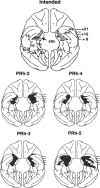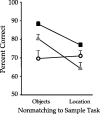Comparison of the effects of damage to the perirhinal and parahippocampal cortex on transverse patterning and location memory in rhesus macaques
- PMID: 15703414
- PMCID: PMC6725995
- DOI: 10.1523/JNEUROSCI.4457-04.2005
Comparison of the effects of damage to the perirhinal and parahippocampal cortex on transverse patterning and location memory in rhesus macaques
Abstract
Monkeys with damage to the parahippocampal (TH/TF) or perirhinal (PRh) cortex were tested on two sets of the transverse patterning (TP) problem (A+/B-, B+/C-, C+/A- and D+/E-, E+/F-, F+/D-) and delayed nonmatching-to-location paradigm (DNML), with delays ranging from 10 to 600 s. Damage to either area impaired acquisition and performance of TP but not of linear discriminations (e.g., A>B>C>X). Damage to areas TH/TF impaired performance of the DNML at all delays but only affected memory for objects at the longest delay, as measured by a delayed nonmatching-to-sample task (DNMS) (Nemanic et al., 2004). Damage to the PRh impaired performance of the DNMS but not of the DNML. The results present a dissociation in object and place memory for these two cortical regions and suggest a role for each in the cortical circuitry supporting configural/relational memory.
Figures





References
-
- Aggleton JP, Keen S, Warburton EC, Bussey TJ (1997) Extensive cytotoxic lesions involving both the rhinal cortices and area TE impair recognition but spare spatial alternation in the rat. Brain Res Bull 43: 279-287. - PubMed
-
- Aggleton JP, Vann SD, Oswald CJ, Good M (2000) Identifying cortical inputs to the rat hippocampus that subserve allocentric spatial processes: a simple problem with a complex answer. Hippocampus 10: 466-474. - PubMed
-
- Alvarado MC, Bachevalier J (2003) Damage to perirhinal and parahippocampal TH/TF cortices impairs performance on transverse patterning. Soc Neurosci Abstr 29: 324.3.
-
- Alvarado MC, Bachevalier J (2005) Selective neurotoxic damage to the hippocampal formation impairs performance of the transverse patterning and location memory tasks in rhesus macaques. Hippocampus 15: 118-131. - PubMed
Publication types
MeSH terms
Grants and funding
LinkOut - more resources
Full Text Sources
Medical
Miscellaneous
